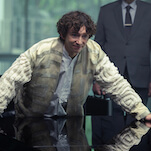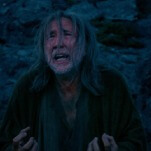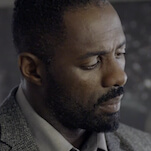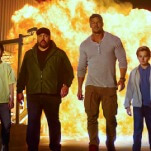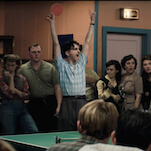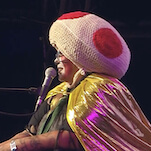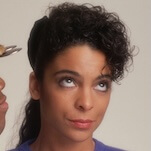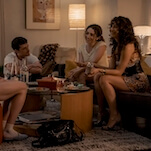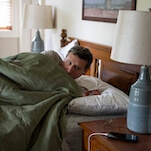Crimes:
- Taking a pretty good idea from the Uruguayan film La Casa Muda—doing a young-woman-alone-in-an-old-dark-house horror movie in real time, in what looks like a single, uninterrupted take—then revealing it’s really about a subject much heavier than previously hinted at, a subject it’s ill-equipped to handle without feeling exploitative
- Squandering a nervy Elizabeth Olsen performance by surrounding her with actors who seem to think they’re appearing in a much less intense film
- Substituting a difficult technical filmmaking feat for substantial material
Defenders: Screenwriter/co-director Laura Lau and her husband/co-director Chris Kentis
Tone of commentary: Like the movie: technically adept, but thematically incompetent. While frequently interrupting each other, the filmmakers discuss the difficulties of working in extended takes, in an unforgivingly tight location, and in the middle of changing lighting conditions, often intensifying each other’s claims. (Lau on an early moment: “It was a very bright day.” Kentis: “It wasn’t just a bright day. It was magic hour.”) But when it comes to the weightier issues at play (spoilers ahead), tied to the late-film revelation that much of what frightens Olsen’s character throughout the house can be traced to suppressed memories of being sexually abused by her father and uncle, both directors seem unsure how to address the scenes substantiatively. “That to me is the most upsetting, unsettling moment in the movie. And it still disturbs me,” Kentis says at the big reveal. Lau agrees: “It is. This is real horror.” That statement defines the banality of certain ways of talking about the banality of evil.
What went wrong: A lot, apparently. Kentis and Lau repeatedly note that one mistake from the cast or crew meant an entire take went “in the trash can.” (Though everyone involved was incredible, of course.) They even point out some mistakes that made it into the movie, particularly a missed cue that led to Olsen getting knocked in the head by an opening door. (She made it work.) But the difficulty only feeds into the mutual back-patting. Listeners are never allowed to forget that making this movie was hard, but Kentis and Lau did it.
Comments on the cast: Kentis and Lau have nothing but praise for “the luminous Elizabeth Olsen.” But you know who the real heroes here are? The filmmakers. Because making this movie was hard. Both Kentis and Lau provide constant reminders: “Basically, we turned this house into our own little mini-soundstage. In order to get these long takes where the camera is spinning around, covering 360 degrees, we had to pre-rig the house, have everything pre-lit, and we had a little dimmer room set aside on the second floor…” Etc.
Inevitable dash of pretension: On the other hand, when Kentis and Lau talk about anything but the technical aspects of their incest spook-show, they can’t help but sound pretentious. “You may notice that we have beds and mattresses that are relatively prominent,” Lau notes. “Beds are interesting, too. Beds have a tremendous amount of symbolism in them. Of course it’s where we cross from between our conscious, waking life and our unconscious, dreaming life, right? So the beds in this film are representing some of the themes of the film.” Later, in case viewers failed to notice how the camera never leaves Olsen’s character, Sarah, Lau says, “The entire movie is this woman’s experience. It’s her reality. It’s how she is seeing things. And how she is experiencing what’s going on. This entire movie is one character’s point of view. It’s Sarah’s point of view. This is what she is actually experiencing.”
Except it isn’t. The final act shows that Sarah, thanks to a split personality, has actually been committing the acts of violence viewers see her stumble upon after the fact, and the whole film has kind of been a con job. What a twist! But don’t call it that. “I hate to call this a twist, because I don’t see it as a twist,” Kentis says of the twist.
And don’t call the way the film uses child abuse exploitative, either. This movie addresses a serious problem. “We’ve had quite a few people come up and speak to us and say this is their… This is what they experienced. This trauma was about them,” says Lau, who notes she did a lot of research into trauma. “Very, very difficult to ever overcome it. You can. You can, absolutely.” Even the movie’s name is aimed at addressing the hidden problem. Kentis: “Of course, the complicity of the family, and how this kind of abuse goes on and nobody stops it…” Lau: “Hence the title: Silent House.”
Commentary in a nutshell: Lau: “I’ll just say the house is Sarah and Sarah is the house, and we wanted the different rooms of the house to represent the different compartments of her mind.”






